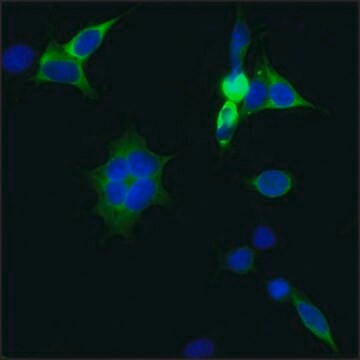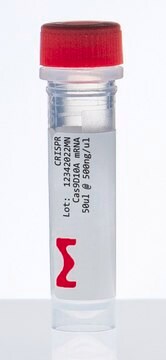CAS9PROT
Cas9 Protein
from Streptococcus pyogenes, recombinant, expressed in E. coli, 1X NLS
Sinónimos:
Cas9, SpCas9, SpyCas9
About This Item
Productos recomendados
recombinant
expressed in E. coli
Quality Level
assay
≥95% (SDS-PAGE)
form
lyophilized powder
packaging
pkg of 1 kit (3 components)
application(s)
CRISPR
shipped in
wet ice
storage temp.
−20°C
Categorías relacionadas
General description
Application
Biochem/physiol Actions
Features and Benefits
- Highly specific
- Highly active
- Ready-to-inject/transfect
Packaging
pkg of 250 μg (≥ 1500 pmol)
Components
- one vial of Cas9 recombinant protein
- one vial containing 1 mL of 1× dilution buffer
- one vial containing 1 mL of nuclease-free water with glycerol
Principle
Reconstitution
Other Notes
Check out our other MISSION® Cas9 Proteins at SigmaAldrich.com/CRISPRproteins
Legal Information
Solo componentes del kit
- Cas9-NLS from Streptococcus pyogenes, expressed in Escherichia coli
- Dilution buffer for Cas9 proteins
- Reconstitution solution for Cas9 proteins
Storage Class
10 - Combustible liquids
flash_point_f
Not applicable
flash_point_c
Not applicable
Elija entre una de las versiones más recientes:
¿Ya tiene este producto?
Encuentre la documentación para los productos que ha comprado recientemente en la Biblioteca de documentos.
Los clientes también vieron
Artículos
After you have performed a CRISPR experiment it is important to determine which gRNAs performed successfully editing. There are many ways to validate CRISPR gene editing experiments. A quick and easy way to check for cutting is by using the Sigma-Aldrich® T7E1 mismatch detection kit.
Protocolos
The CRISPR (Clustered Regularly Interspaced Short Palindromic Repeats) system was discovered in bacteria, where it functions as an adaptive immune system against invading viral and plasmid DNA.
Guaranteed PURedit™ CRISPR synthetic gRNAs and Cas9 protein offer industry-leading on-site cutting and specificity
Contenido relacionado
Watch Cas9-GFP proteins work inside your cells and deliver the powerful nuclease editing you have come to trust and expect. MISSION™ SpCas9-GFP and eSpCas9-GFP proteins are multi-functional enzymes with high on-target cleavage efficiency fused to Enhanced Green Fluorescent Protein (EGFP) for real-time observation of Cas9 delivery and clearance from cells.
Global Trade Item Number
| Número de referencia del producto (SKU) | GTIN |
|---|---|
| CAS9PROT-2X250UG | 4022536097381 |
| CAS9PROT-250UG | 4061833531563 |
| CAS9PROT-4X250UG | 4022536097398 |
| CAS9PROT-50UG | 4061833531570 |
Nuestro equipo de científicos tiene experiencia en todas las áreas de investigación: Ciencias de la vida, Ciencia de los materiales, Síntesis química, Cromatografía, Analítica y muchas otras.
Póngase en contacto con el Servicio técnico














